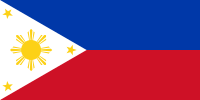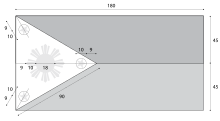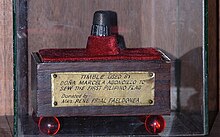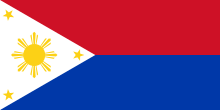Flag of the Philippines
| Flag of the Philippines | |
|---|---|
 |
|
| Vexillological symbol : |
|
| Aspect ratio: | 1: 2 |
| Officially accepted: | June 12, 1898 |
The national flag of the Philippines was introduced on June 12, 1898, but changed in color several times over the years. It was originally designed by Emilio Aguinaldo . The flag of the Philippines is hoisted with the blue field up in peacetime, while the red field is on top in wartime.
design
construction
The national flag consists of two horizontal stripes of equal width in the colors royal blue and scarlet red , which are covered by a white equilateral triangle on the leech . The center of the triangle occupies a golden sun, which is surrounded by eight main rays. Each of the rays in turn consists of three individual rays. A five-pointed gold star is also placed at each corner of the triangle. Each star is laid out in such a way that one of the points points exactly to the tip of the corner where it is located.
The sides of the flag have a length to width ratio of 2: 1. The dimensions of all three sides of the white triangle correspond to the width of the flag.
Their colors are determined by Republic Act No. 8491 and refer to color numbers developed by the Color Association of the United States to standardize textile colors. The official colors and their adjustments in other color spaces are listed below:
| Scheme | blue | red | White | yellow |
|---|---|---|---|---|
| Color number (USA) | 80173 | 80108 | 80001 | 80068 |
| Pantone | 286 | 186 | n / A | 116 |
| RGB | 0-56-168 | 206-17-38 | 255-255-255 | 252-209-22 |
| CMYK | C100-M60-Y0-K5 | C0-M90-Y65-K10 | n / A | C0-M18-Y85-K0 |
| HEX | # 0038A8 | # CE1126 | #FFFFFF | # FCD116 |
symbolism
According to official sources, the white triangle stands for equality, the blue field for peace, truth and justice, and the red field for patriotism and heroism. The eight-pointed sun stands for freedom and the eight provinces in which the Philippine Revolution broke out against the Spanish colonial power in 1896 ( Batangas , Bulacan , Cavite , Laguna , Manila , Nueva Ecija , Pampanga and Tarlac ), and for those related to this Time martial law was proclaimed. The three stars symbolize the main geographic areas of Luzon , Mindanao and the Visayas group of islands.
The symbolism given to the flag in 1898 when Filipino independence was proclaimed, however, differs from today's official interpretation. At that time, the white triangle alluded to the emblem of Katipunan , the secret organization that rebelled underground against Spanish rule. It is said that the colors of the flag were based on the flag of the United States as an expression of gratitude for American support in the fight against the Spanish during the Philippine Revolution . According to another interpretation, one of the three stars should stand alone for the island of Panay and not represent the entire Visayas.
Flag history
Historical flags
In the 1960s, a general beginning to trace the development of the Philippine flag, starting from the war standards of individual leaders of the Katipunan, a revolutionary pseudo Masonic movement that rebelled against Spanish rule and that led the country into the Philippine Revolution. While some symbols of various flags of the Katipunan have similarities with the national flag and these have their place in the iconography of the revolution, it is not clear whether these war standards can be regarded as the forerunners of the present day Philippine flag.
The first flag of the Katipunan was a red rectangular flag with a horizontal grouping of three Ks (an acronym of the full name of the Katipunan, Kataas-taasang Kagalang-galangang Katipunan ng mga Anak ng Bayan - Highest and most venerable community of the children of this nation). The red field of the flag is said to stand for blood, as the members of the Katipunan signed their membership with their own blood.
The various leaders of the organization, such as Andrés Bonifacio , Emilio Aguinaldo and Gregorio del Pilar , each had their own standards of war. During the course of the revolution, one arm of the organization in Cavite split off and two factions of the Katipunan emerged: the Magdiwang and the Magdalo faction, each of which adopted its own flag.
The Katipunan decided to adopt a new flag during the Naic Assembly in 1897 . This was red and represented a white sun with a face. The sun had eight rays that stood for the eight provinces that had been placed under martial law by the Spaniards at the beginning of the conflict .
 ? The first flag of the Katipunan.
? The first flag of the Katipunan.
 ? Flag of the Magdalo faction.
? Flag of the Magdalo faction.
 ? Flag of the Magdiwang faction.
? Flag of the Magdiwang faction.
 ? Flag of the Republic of Biak-na-Bato (1897).
? Flag of the Republic of Biak-na-Bato (1897).
Current design
The current design of the Philippine national flag was conceived by Emilio Aguinaldo , a general of the Philippine Revolution when he was in exile in Hong Kong in late 1897 . The first flag was sewn by Doña Marcela Marino de Agoncillo , who she made with the help of her daughter Lorenza and with the support of Doña Delfina Herbosa de Natividad, a niece of the Reformation leader José Rizal .
However, the flag was not formally unfolded for the first time until the declaration of Philippine independence on June 12, 1898 in Kawit . According to an article in the Manila Times by Augusto de Viana, a respected historian with the National Institute of History, historical textbooks and memorial rites mention that the flag was first hoisted on May 28, 1898 at the Battle of Alapan, a district from Imus in Cavite . This is also quoted in Presidential Proclamation No. 374, issued by President Diosdado Macapagal on March 6, 1965. The article goes on to say that historical records suggest the flag was first used in Cavite City when General Aguinaldo unfurled it during the first fighting in the Spanish-American War .
The original symbolism of the flag was included in the text of the Declaration of Independence and refers to an attached drawing, of which, however, no copy is left. The original design of the flag adopts a common symbol of various former Spanish colonies, a mythical sun with a face that was a common symbol of these countries. The exact color of the blue field of the original flag is part of a lot of contentious discussions. Based on anecdotal evidence and the few remaining flags from that period, historians argue that the color was the same blue and red hue that the flag of Cuba had. Indeed, the Cuban flag influenced the design of the Filipino flag, just as Cuba's revolution against the Spaniards inspired the Filipino revolution.
Then in 1899 hostilities broke out between Filipino soldiers and United States forces . The flag was the symbol of the first Philippine republic and was thus hoisted for the first time on February 4, 1899, with the red field facing upwards, in order to prove the war status with the USA. Aguinaldo was captured by the Americans two years later and subsequently swore allegiance to the United States.
With the defeat of the first Philippine Republic, the country came under the rule of the American colonial administration, making the use of the Philippine flag illegal with the Sedition Act in 1907. This law was repealed on October 30, 1919. At the time of the renewed legitimation of the Philippine flag, fabrics in most textile shops were only available in the red and blue hue of the flag of the United States , which meant that the flag had to be given the color navy blue from 1919 onwards. The Philippine Legislature finally issued Ordinance No. 2928 on March 26, 1920, according to which the Philippine flag of the First Republic was adopted as the official flag of the Philippine Islands. From then until the time of the Japanese occupation in World War II, October 30 was observed as Flag Day, to commemorate the date on which the American administration banned the raising of the flag.
In 1935 the Commonwealth of the Philippines was finally established. On March 25, 1936, President Manuel Quezon issued Executive Order No. 23, which laid down the technical specifications and specifications of the flag. The ordinance integrated the definition of the triangle on the train side as an equilateral triangle , the aspect ratio of 1: 2, as well as the exact angles of the stars, the geometrical and aesthetic representation of the sun and the formal distance of the face from the sun. These specifications have remained unchanged to this day and are therefore still valid. The exact color tones, however, were not precisely defined. In 1941, Flag Day was officially rescheduled to June 12th to commemorate the proclamation of the Philippine Declaration of Independence in 1898.
The flag was banned again with the invasion and occupation of the Philippines in early December 1941, only to be taken over again by the Japanese-backed establishment of the Second Republic of the Philippines. In a ceremony in October 1943, Emilio Aguinaldo's flag was ceremoniously hoisted in the original Cuban red and blue tones, with the blue side up first, before President José P. Laurel declared a state of war with the Allies in 1944 . The Commonwealth government-in-exile in Washington, DC , on the other hand , retained the flag with the American colors and had it set with the red field facing up since the Japanese invasion. With the return of the Philippine and American forces and the liberation of the Philippines in 1944, American colors returned and were adopted for the future upon the official declaration of independence from the United States on July 4, 1946.
Design change
colour
In 1955, the National Historical Institute adopted a color specification based on the hues of the American flag. In 1985, President Ferdinand Marcos ordered a return of the colors to the original red and blue hues of the Cuban flag. However, this ordinance was reversed after Marco's disempowerment. For the 100th anniversary of the Philippine declaration of independence in 1998, Republic Act 8491 was passed, which redefined the color of the flag and the coat of arms and now defined the blue color as royal blue .
Sunbeams
Even before the centenary celebrations in 1998, the Zambales provincial government requested that the sunbeams be increased to nine, as their province had been equally involved in the 1896 rebellion. However, after research by the National Historical Institute, the responsible commission rejected the application.
Used flags
 ? Union Jack , during the British occupation from 1762 to 1764
? Union Jack , during the British occupation from 1762 to 1764
 ? Flag of Spain , in use during the Spanish East Indies , 1821 to 1898
? Flag of Spain , in use during the Spanish East Indies , 1821 to 1898
 ? Flag of the First Philippine Republic by Emilio Aguinaldo, 1898 to 1901
? Flag of the First Philippine Republic by Emilio Aguinaldo, 1898 to 1901
 ? Flag of the USA with 45 stars, 1901 to 1908
? Flag of the USA with 45 stars, 1901 to 1908
 ? Flag of the USA (with 46 stars), 1908 to 1912
? Flag of the USA (with 46 stars), 1908 to 1912
 ? Flag of the USA (48 stars), used in the Philippines from 1912 to 1919
? Flag of the USA (48 stars), used in the Philippines from 1912 to 1919
 ? Flag of the Philippines, 1919 to 1941
? Flag of the Philippines, 1919 to 1941
 ? Flag of the Philippines, 1942 to 1943
? Flag of the Philippines, 1942 to 1943
 ? Flag of the Philippines (Second Republic), 1943-1944
? Flag of the Philippines (Second Republic), 1943-1944
 ? Flag of the Philippines, 1944 to 1985
? Flag of the Philippines, 1944 to 1985
 ? Flag of the Philippines, 1985 to 1986
? Flag of the Philippines, 1985 to 1986
 ? Flag of the Philippines, 1986 to 1998
? Flag of the Philippines, 1986 to 1998
 ? Flag of the Philippines, since 1998
? Flag of the Philippines, since 1998
protocol
Formal use
The flag is supposed to fly every day of the year in every government building, in the official residences of the president, in public places as well as in schools. The days from May 28th (National Flag Day) to June 12th (Independence Day) are designated as Flag Days when all government institutions, business establishments and private buildings are required to fly the national flag.
By law, the Filipino flag has to be permanently set in the following places and illuminated at night:
- at the Philippine Senate and at the Philippine House of Representatives of the Congress of the Philippines
- at the Supreme Court of the Philippines
- in Rizal Park
- at the Aguinaldo shrine in Kawit
- in front of the Barasoain Church in Malolos City
- at the Tomb of the Unknown Soldier in the Heroes Cemetery in Taguig City
- at the Mausoleo de los Veteranos de la Revolución, the mausoleum for the veterans of the revolution at the North Cemetery of Manila
- at all international access points such as shipping and airports
- at all places determined by the National Historical Institute in this regard
What is unique about the Philippine flag is that it tells you whether the country is at war. In wartime, the flag is rotated so that the red side is facing up; when the flag is used vertically in wartime, the red stripe is on the left from the viewer's point of view. In peacetime, however, the blue field can be seen above or on the left.
Half mast

The flag is raised to half-mast as a sign of mourning . After the official announcement of the death of a president or former president, the flag is said to fly at half-mast for ten days. The flag shall be hoisted for seven days following the death of a Vice President, Chief Justice, Senate President or Speaker of the House of Representatives.
It may be necessary to hoist the flag at half-mast even after the death of another person, if that person has been designated for that honor by the National Historical Institute. In this case, however, this status will be maintained for less than seven days. The flag should be set at half-mast in front of all buildings and places where the deceased performed his office, from the day of his death to the day of the burial. This applies to an incumbent member of the Supreme Court, Cabinet, Senate or House of Representatives and to those appointed by the National Historical Institute.
When the flag is raised to half-mast it is first raised to the highest point, where it lingers for a moment before being lowered to the half-mast position. It should also be pulled to the highest point before it is finally taken down for that day.
The flag is said to continue to cover the coffin of a dead soldier, a veteran of a former war, a national artist, and a special civilian designated by the local government. In this case, the flag should be placed so that the white triangle is on the head and the blue field covers the right side of the coffin. The flag should not be lowered into the grave or even touch the ground, but should be ceremonially folded and placed in the hands of the relatives of the deceased.
It is forbidden to deface or mock the flag, lower it in the salute or add additional signs or markings of any kind. It may not be used as a curtain, garland, tablecloth, for wrapping objects or as part of a costume or uniform.
Various commercial uses of the flag are prohibited, including use as a trademark or in commercial writing or design. It is also not permitted to attach the image of the flag to commercial goods or to use it in any advertising. Nor should it be used as a pennant on the bonnet, side, rear, or roof of a motorized vehicle.
The flag is not intended to be hung in the wrong way or under a picture, photo or under a pedestal. The same applies to "frivolous places" that are used for exuberance, amusement or relaxation.
Pledge
The pledge of allegiance to the Filipino flag should be made while standing with the right hand with open palms and shoulder raised. Individuals whose beliefs and religious convictions prohibit such a pledge are permitted to exempt themselves from it. Nonetheless, visible and full respect is expected from these people when the vow is honored by the other standing at attention.
|
|
The law does not indicate the language in which the pledge would be carried forward, written down but it was in the official Philippine language Filipino .
More flags of the Philippines
Jack of the Navy of the Philippines
See also
- Lupang Hinirang (national anthem)
Web links
- Flag Act of the Philippines (English)
- Flags of the World - Philippines (English)
- The Evolution of the Philippine Flag (English)
- The Controversial Philippine National Flag (English)
- Historical flags of Sulu (English)
Individual evidence
- ↑ a b c d e Republic Act No. 8491 . Retrieved June 6, 2007.
- ↑ Dictionary of Vexillology C . Flags of the World. Retrieved June 6, 2007.
- ^ Philippines . Vexilla Mundi. Retrieved June 6, 2007.
- ↑ a b Flag and Anthem . The Official Website of the Republic of the Philippines. Retrieved June 6, 2007.
- ↑ a b Flag of Philippines . CIA World Factbook. Archived from the original on June 16, 2009. Info: The archive link was inserted automatically and has not yet been checked. Please check the original and archive link according to the instructions and then remove this notice. Retrieved June 6, 2007.
- ^ Declaration of Philippine Independence . Retrieved June 6, 2007.
- ↑ a b c d e f g Manuel L. III Quezon: History of the Philippines Flag . Flags of the World. April 2, 2002. Archived from the original on February 5, 2008. Info: The archive link was automatically inserted and not yet checked. Please check the original and archive link according to the instructions and then remove this notice. Retrieved June 6, 2007.
- ↑ a b Augusto de Viana: Where was the Filipino Flag first unfurled? . May 28, 2008. Archived from the original on June 24, 2008. Info: The archive link was automatically inserted and has not yet been checked. Please check the original and archive link according to the instructions and then remove this notice. Retrieved May 28, 2008.
- ↑ Manuel L. Quezon III: Philippines: the shade of blue . In: Flags of the World . April 12, 2002. Archived from the original on August 18, 2011. Info: The archive link was automatically inserted and not yet checked. Please check the original and archive link according to the instructions and then remove this notice. Retrieved December 22, 2007.
- ↑ Adjusting the rays of the flag? . In: Flags of the World . March 9, 1998. Archived from the original on June 27, 2008. Info: The archive link was automatically inserted and not yet checked. Please check the original and archive link according to the instructions and then remove this notice. Retrieved June 15, 2008.






















